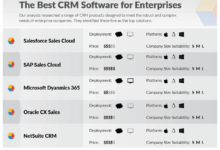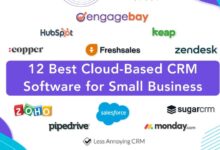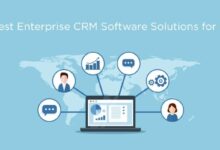CRM for Sales and Marketing Automation
CRM for Sales and Marketing Automation represents a powerful synergy, streamlining processes and boosting efficiency for both sales and marketing teams. By unifying data and automating tasks, businesses can cultivate more effective customer relationships, leading to improved lead generation, conversion rates, and ultimately, increased revenue. This integration allows for personalized marketing campaigns directly tied to sales efforts, providing valuable insights into customer behavior and preferences.
This exploration delves into the core functionalities of such systems, examining the benefits of a unified approach compared to disparate sales and marketing tools. We will cover key features like workflow automation, lead scoring, email marketing capabilities, and data management, while also addressing critical aspects such as implementation, ROI measurement, and future trends shaping this dynamic field.
Defining CRM for Sales and Marketing Automation
A Customer Relationship Management (CRM) system, when enhanced with marketing automation capabilities, becomes a powerful tool for businesses to manage interactions with current and potential customers. It streamlines processes, improves efficiency, and ultimately drives revenue growth by fostering better communication and understanding of customer needs across both sales and marketing departments.
A CRM system at its core manages customer data, interactions, and sales processes. For sales, this means tracking leads, managing opportunities, and monitoring sales performance. Marketing functions within a CRM involve managing campaigns, analyzing marketing performance, and nurturing leads through automated workflows. The integration of sales and marketing data within a unified platform is key to achieving a holistic view of the customer journey.
Core Functionalities of a Sales and Marketing CRM
A comprehensive CRM for sales and marketing automation encompasses a broad range of functionalities. These include contact management (centralized storage and organization of customer data), lead management (tracking and nurturing potential customers), sales pipeline management (visualizing and managing the sales process), marketing campaign management (planning, executing, and analyzing marketing activities), reporting and analytics (measuring the effectiveness of sales and marketing efforts), and integration with other business systems (enhancing data flow and functionality). Furthermore, automation features, such as automated email sequences, lead scoring, and social media integration, significantly boost efficiency.
Key Differences Between Sales-Only and Integrated CRMs
A sales-only CRM focuses primarily on sales processes, offering tools for managing leads, tracking deals, and analyzing sales performance. An integrated CRM, however, extends these functionalities to include marketing automation capabilities. This integration allows for seamless lead nurturing, targeted marketing campaigns, and a more holistic view of the customer journey. The key difference lies in the ability of an integrated CRM to connect sales and marketing efforts, fostering collaboration and improving overall efficiency. A sales-only CRM operates in isolation from marketing activities, potentially leading to data silos and inefficiencies.
Benefits of a Unified CRM for Sales and Marketing Teams
A unified CRM offers significant benefits to both sales and marketing teams. Sales teams gain access to detailed customer information and marketing campaign insights, enabling them to personalize their interactions and close deals more effectively. Marketing teams benefit from valuable sales data, allowing them to refine their targeting and optimize campaign performance. This shared access to information fosters better collaboration, eliminates data silos, and provides a 360-degree view of the customer, leading to improved customer satisfaction and increased revenue. For example, a marketing campaign can identify high-potential leads, which are then seamlessly passed to the sales team for personalized follow-up.
Comparison of Leading CRM Platforms
| Feature | Salesforce Sales Cloud | HubSpot CRM | Microsoft Dynamics 365 |
|---|---|---|---|
| Contact Management | Excellent; robust features, customizable fields | Good; user-friendly interface, easy to navigate | Good; strong integration with other Microsoft products |
| Lead Management | Excellent; advanced lead scoring and routing | Excellent; built-in lead nurturing tools | Good; integrates well with marketing automation platforms |
| Sales Pipeline Management | Excellent; customizable pipeline views and reporting | Good; visual pipeline tracking | Good; robust reporting and analytics |
| Marketing Automation | Excellent; powerful automation tools, email marketing, etc. (requires Marketing Cloud add-on) | Excellent; comprehensive marketing automation features built-in | Good; requires integration with other marketing automation tools |
Sales Automation Features within a CRM
A Customer Relationship Management (CRM) system significantly boosts sales efficiency by automating repetitive tasks and providing valuable insights. This automation streamlines the sales process, freeing up sales representatives to focus on higher-value activities like building relationships and closing deals. The features described below illustrate how a CRM empowers sales teams to work smarter, not harder.
Workflow Automation Capabilities
Workflow automation within a CRM system refers to the ability to automate various stages of the sales process, from lead capture to deal closure. This automation is achieved through the use of pre-defined rules and triggers that automatically execute specific actions based on predefined criteria. For example, when a lead fills out a contact form on a company website, the CRM can automatically add them to a specific lead list, assign them to a sales representative, and send them a welcome email. This eliminates manual data entry and ensures consistent follow-up across all leads. More complex workflows can involve multiple steps and conditional logic, ensuring that the right actions are taken at the right time.
Lead Scoring and Lead Nurturing Implementation
Lead scoring and lead nurturing are critical components of a sales-focused CRM. Lead scoring assigns a numerical value to each lead based on pre-defined criteria such as demographics, website activity, and engagement with marketing materials. Leads with higher scores are prioritized for follow-up, indicating a greater likelihood of conversion. Lead nurturing involves using automated email sequences and other communication methods to engage leads over time and move them through the sales funnel. This process can include sending targeted content, providing valuable resources, and answering questions, all designed to build relationships and increase the chances of a sale. For example, a lead who downloads a whitepaper might receive a follow-up email with a related case study, further nurturing their interest and building trust.
Sales Reports and Dashboards
CRMs generate a wide array of reports and dashboards to provide valuable insights into sales performance. These tools offer a comprehensive overview of key metrics, enabling sales managers to track progress, identify areas for improvement, and make data-driven decisions. Examples of common reports include sales pipeline analysis, forecasting reports, win/loss analysis, and sales representative performance reports. Dashboards typically provide a visual representation of key metrics, such as the number of qualified leads, conversion rates, and revenue generated. A well-designed dashboard allows sales managers to quickly assess the health of the sales pipeline and identify potential problems. For instance, a drop in conversion rates might indicate a need to refine the sales process or improve lead nurturing strategies.
Sales Process Flowchart
The following flowchart illustrates a typical sales process managed by a CRM:
[Imagine a flowchart here. The flowchart would start with “Lead Generation” (e.g., website form submission, inbound call). This would feed into “Lead Qualification” (CRM automatically scores leads based on predefined criteria). Qualified leads would then move to “Contact & Nurture” (automated email sequences, personalized content). Successful nurturing would lead to “Opportunity Creation” (sales rep creates an opportunity record in the CRM). Next is “Proposal & Negotiation” (CRM tracks communication, documents, and proposals). Successful negotiation leads to “Closing the Deal” (CRM records the closed-won opportunity). Finally, “Post-Sale Follow-up” (automated thank you emails, ongoing support) closes the loop. Each stage would ideally show how the CRM facilitates the process, e.g., automated email sequences, lead scoring, and reporting.]
Marketing Automation Features within a CRM
A CRM system significantly enhances marketing efforts by automating repetitive tasks and providing valuable data-driven insights. This allows marketing teams to focus on strategic initiatives and deliver more personalized experiences to their customers. Integrating marketing automation directly within a CRM streamlines processes, improving efficiency and overall campaign effectiveness.
Email Marketing Capabilities within a CRM
CRMs offer robust email marketing capabilities, going beyond simple email sending. They provide features such as automated email sequences, personalized email content based on customer interactions, and detailed tracking of email performance. This enables marketers to nurture leads, segment audiences, and measure the effectiveness of their email campaigns with precision. For example, a welcome email series could automatically be triggered upon a new customer signup, followed by personalized product recommendations based on their purchase history. A/B testing capabilities allow marketers to optimize email subject lines and content for maximum engagement.
Types of Marketing Campaigns Managed Through a CRM
A wide array of marketing campaigns can be effectively managed through a CRM’s marketing automation features. These include lead nurturing campaigns designed to guide prospects through the sales funnel, email marketing campaigns focused on announcements, promotions, and customer retention, social media marketing campaigns coordinating social media engagement with CRM data, and SMS marketing campaigns providing targeted text message communications. These campaigns leverage the CRM’s data to personalize messaging and target specific customer segments.
Examples of Personalized Marketing Efforts Facilitated by a CRM
CRMs facilitate highly personalized marketing by leveraging customer data to tailor messaging and offers. For instance, a CRM can segment customers based on demographics, purchase history, and website behavior. This allows marketers to send targeted emails promoting relevant products or services. Personalized recommendations can be incorporated into email campaigns and website experiences, enhancing customer engagement. Birthday emails with special offers, or targeted ads based on browsing history, are examples of personalization enabled by a CRM’s marketing automation capabilities.
Metrics Used to Measure Marketing Campaign Success
Effective measurement is crucial for optimizing marketing campaigns. Key metrics tracked within a CRM include open rates and click-through rates for email campaigns, conversion rates from leads to customers, customer lifetime value (CLTV), return on investment (ROI) for marketing spend, website engagement metrics such as time spent on site and pages visited, and social media engagement metrics like likes, shares, and comments. Analyzing these metrics provides valuable insights into campaign performance, enabling data-driven improvements and strategic adjustments.
Integration and Data Management
A robust CRM system is not just a collection of sales and marketing tools; it’s a centralized hub where data from various sources converges to provide a holistic view of the customer journey. Effective integration and data management are crucial for maximizing the efficiency and effectiveness of both sales and marketing efforts. Without seamless data flow, valuable insights remain fragmented, hindering informed decision-making and optimized strategies.
Data integration between sales and marketing within a CRM ensures a unified view of the customer, eliminating data silos and promoting collaboration. This unified view allows sales teams to access detailed marketing campaign performance data to understand which leads are most qualified, while marketing teams can leverage sales insights to personalize campaigns and refine targeting. This synergy leads to improved lead nurturing, increased conversion rates, and ultimately, higher revenue.
Customer Data Privacy and Security
CRMs employ various measures to protect customer data. These typically include data encryption both in transit and at rest, access controls limiting data visibility based on roles and permissions, and regular security audits to identify and address vulnerabilities. Compliance with data privacy regulations such as GDPR and CCPA is also paramount, often involving features like data subject access requests and consent management tools. Robust security protocols are essential to maintain customer trust and avoid legal repercussions.
Data Import and Export Methods
CRMs offer diverse methods for importing and exporting data, catering to various needs and data formats. Common import methods include CSV file uploads, direct database connections, and API integrations. Export options often mirror these, allowing for data extraction in various formats suitable for analysis in external tools or for data sharing with other systems. The choice of method depends on factors such as data volume, data format, and the desired level of automation. For instance, a large database might necessitate a direct database connection for efficiency, while smaller datasets could be easily handled through CSV uploads.
Marketing Activities and Sales Conversions Report
The following hypothetical report illustrates the relationship between marketing activities and sales conversions. It demonstrates how a CRM can be used to analyze campaign effectiveness and identify high-performing channels. This data is illustrative and could be easily replicated using real-world CRM data.
| Marketing Campaign | Leads Generated | Sales Qualified Leads (SQLs) | Conversions |
|---|---|---|---|
| Email Marketing Campaign A | 500 | 100 | 20 |
| Social Media Campaign B | 300 | 75 | 15 |
| Paid Search Campaign C | 200 | 50 | 10 |
| Content Marketing Campaign D | 400 | 80 | 16 |
This report shows that, while Email Marketing Campaign A generated the most leads, Content Marketing Campaign D had a relatively high conversion rate. This information allows for data-driven decisions regarding future marketing resource allocation. Further analysis could delve into specific aspects of each campaign to optimize performance even further.
Implementation and ROI
Successfully implementing a CRM for sales and marketing automation requires careful planning and execution. A well-structured implementation process minimizes disruption, ensures user adoption, and maximizes the return on investment. This involves understanding the steps involved, choosing the right vendor, and establishing clear metrics to track success.
Implementing a CRM system is a multi-stage process demanding careful consideration at each step. The success of the implementation directly correlates with the thoroughness of the planning and execution. Understanding the complexities and potential challenges upfront can significantly reduce implementation time and increase user satisfaction.
CRM Implementation Steps
The implementation of a CRM system typically involves several key phases. First, a thorough needs assessment is conducted to determine the specific requirements of the organization. This is followed by the selection of a suitable CRM vendor and the system itself. Next, data migration from existing systems takes place, often requiring data cleansing and transformation. Then, the system is configured to match the organization’s workflows and processes. Finally, user training and ongoing support are crucial for successful adoption and long-term effectiveness. Throughout this process, regular monitoring and adjustments are essential to ensure the system meets its objectives.
CRM Vendor Selection Factors
Choosing the right CRM vendor is critical for long-term success. Key factors to consider include the vendor’s reputation, the functionality and scalability of their CRM system, the level of customization offered, the quality of their support and training, and the overall cost of ownership, including implementation, maintenance, and ongoing support fees. Evaluating the vendor’s experience with similar businesses and their ability to meet specific business needs is also essential. Compatibility with existing systems and the vendor’s long-term viability are additional crucial factors. For example, a company might prioritize a vendor with a strong track record in their industry and a proven ability to scale as the company grows.
Measuring CRM ROI
Measuring the return on investment (ROI) of a CRM system requires a multifaceted approach. Companies can track key performance indicators (KPIs) such as increased sales conversion rates, improved customer satisfaction scores, reduced customer acquisition costs, enhanced lead generation, and improved sales team productivity. For instance, a company might track the increase in sales closed per representative after CRM implementation, or the reduction in time spent on administrative tasks. A quantifiable example could be a 15% increase in sales conversion rates resulting in an additional $500,000 in revenue within a year. This increase can then be compared to the total cost of the CRM implementation to calculate the ROI.
Challenges and Solutions During CRM Implementation
Effective planning and execution mitigate potential challenges. Understanding these challenges ahead of time is crucial for successful implementation.
- Challenge: Inadequate user training and adoption. Solution: Invest in comprehensive training programs, provide ongoing support, and involve users in the implementation process.
- Challenge: Data migration issues. Solution: Implement a robust data migration plan, cleanse and standardize data before migration, and thoroughly test the migrated data.
- Challenge: Integration problems with existing systems. Solution: Choose a CRM system with strong integration capabilities and work with experienced integration specialists.
- Challenge: Lack of management support. Solution: Secure executive sponsorship and clearly communicate the benefits of the CRM system to all stakeholders.
- Challenge: Insufficient customization and configuration. Solution: Work closely with the CRM vendor to customize the system to meet specific business needs and ensure it aligns with existing workflows.
Future Trends
The landscape of CRM technology is constantly evolving, driven by advancements in artificial intelligence, shifting customer expectations, and the rise of omnichannel marketing. Understanding these emerging trends is crucial for businesses aiming to leverage CRM for optimal sales and marketing performance. The future of CRM lies in its ability to become more intelligent, personalized, and integrated across all customer touchpoints.
The integration of AI and machine learning is fundamentally reshaping CRM capabilities. This allows for more sophisticated automation, predictive analytics, and personalized customer experiences.
AI and Machine Learning’s Impact on CRM
AI and machine learning are enhancing CRM systems in several key ways. Predictive analytics, powered by machine learning algorithms, can forecast sales trends, identify high-potential leads, and predict customer churn. This allows sales and marketing teams to proactively address potential issues and optimize their strategies. AI-powered chatbots are improving customer service by providing instant support and answering frequently asked questions, freeing up human agents to handle more complex issues. Furthermore, AI algorithms are enabling increasingly sophisticated personalization of marketing campaigns, tailoring messages and offers based on individual customer preferences and behaviors. For example, a clothing retailer might use AI to recommend products based on a customer’s past purchases, browsing history, and even social media activity, leading to higher conversion rates. Sales teams can benefit from AI-driven insights into optimal contact strategies, timing, and messaging, leading to increased sales efficiency.
CRM Adapting to Changing Customer Expectations
Modern customers expect seamless, personalized experiences across all channels. They want consistent interactions regardless of whether they are interacting through email, social media, a website, or in person. CRM systems are adapting to meet these expectations by offering improved omnichannel capabilities and enhanced personalization features. For instance, a CRM system can track customer interactions across multiple channels, providing a unified view of the customer journey. This allows businesses to offer consistent and personalized experiences, regardless of how the customer chooses to interact. CRM systems are also incorporating features that enable personalized communication at scale. This might involve using AI to segment customers based on their preferences and behavior, and then delivering targeted messages through the appropriate channel. Consider a bank that uses CRM to personalize email campaigns based on a customer’s financial goals and risk tolerance. This results in more effective marketing and strengthens customer relationships.
CRM’s Role in Omnichannel Marketing Strategies
Omnichannel marketing is becoming increasingly crucial for businesses to reach and engage customers effectively. A successful omnichannel strategy requires a unified view of the customer across all touchpoints. CRM systems play a vital role in enabling this by providing a central repository for customer data from various sources, including website activity, social media interactions, email campaigns, and customer service interactions. This unified view allows businesses to create more personalized and consistent customer experiences across all channels. For example, a customer might start their journey by browsing products on a company’s website. The CRM system then tracks this activity, allowing the company to send personalized email recommendations. Later, if the customer calls customer service, the agent can access the complete customer history within the CRM system, ensuring a seamless and consistent experience. This integrated approach fosters stronger customer relationships and improves overall customer satisfaction.
End of Discussion
Implementing a CRM for sales and marketing automation is a strategic investment that can significantly transform a business. By optimizing workflows, personalizing customer interactions, and gaining valuable data-driven insights, companies can achieve a substantial return on investment. The future of CRM lies in leveraging AI and machine learning to further enhance efficiency and deliver even more personalized customer experiences across all channels. Embracing this technology is crucial for businesses aiming to thrive in today’s competitive landscape.





